formerly eScholarship Editions


|
|
|
|
Your request for similar items found 20 book(s). | Modify Search | Displaying 1 - 20 of 20 book(s) | |
| 1. | 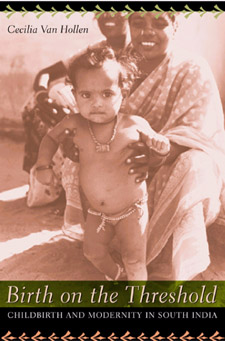 | Title: Birth on the threshold: childbirth and modernity in South India Author: Van Hollen, Cecilia Coale Published: University of California Press, 2003 Subjects: Anthropology | Cultural Anthropology | Medical Anthropology | Sociology | Gender Studies | Hinduism | South Asia | Asian Studies | South Asia | South Asia Publisher's Description: Even childbirth is affected by globalization - and in India, as elsewhere, the trend is away from home births, assisted by midwives, toward hospital births with increasing reliance on new technologies. And yet, as this work of critical feminist ethnography clearly demonstrates, the global spread of biomedical models of childbirth has not brought forth one monolithic form of "modern birth." Focusing on the birth experiences of lower-class women in the South Indian state of Tamil Nadu, Birth on the Threshold reveals the complex and unique ways in which modernity emerges in local contexts. Through vivid description and animated dialogue, this book conveys the birth stories of the women of Tamil Nadu in their own voices, emphasizing their critiques of and aspirations for modern births today. In light of these stories, author Cecilia Van Hollen explores larger questions about how the structures of colonialism and postcolonial international and national development have helped to shape the form and meaning of birth for Indian women today. Ultimately, her book poses the question: How is gender - especially maternity - reconfigured as birth is transformed? [brief] Similar Items |
| 2. | 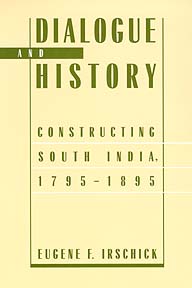 | Title: Dialogue and history: constructing South India, 1795-1895 Author: Irschick, Eugene F Published: University of California Press, 1994 Subjects: History | Asian History | South Asia | Cultural Anthropology Publisher's Description: Eugene Irschick deftly questions the conventional wisdom that knowledge about a colonial culture is unilaterally defined by its rulers. Focusing on nineteenth-century South India, he demonstrates that a society's view of its history results from a "dialogic process" involving all its constituencies.For centuries, agricultural life in South India was semi-nomadic. But when the British took dominion, they sought to stabilize the region by inventing a Tamil "golden age" of sedentary, prosperous villages. Irschick shows that this construction resulted not from overt British manipulation but from an intricate cross-pollination of both European and native ideas. He argues that the Tamil played a critical role in constructing their past and thus shaping their future. And British administrators adapted local customs to their own uses. [brief] Similar Items |
| 3. | 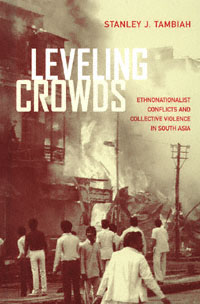 | Title: Leveling crowds: ethnonationalist conflicts and collective violence in South Asia Author: Tambiah, Stanley Jeyaraja 1929- Published: University of California Press, 1997 Subjects: Anthropology | South Asia | Politics | Asian History | Religion Publisher's Description: Ethno-nationalist conflicts are rampant today, causing immense human loss. Stanley J. Tambiah is concerned with the nature of the ethno-nationalist explosions that have disfigured so many regions of the world in recent years. He focuses primarily on collective violence in the form of civilian "riots" in South Asia, using selected instances in Sri Lanka, Pakistan, and India. He situates these riots in the larger political, economic, and religious contexts in which they took place and also examines the strategic actions and motivations of their principal agents. In applying a wide range of social theory to the problems of ethnic and religious violence, Tambiah pays close attention to the history and culture of the region.On one level this provocative book is a scrupulously detailed anthropological and historical study, but on another it is an attempt to understand the social and political changes needed for a more humane order, not just in South Asia, but throughout the world. [brief] Similar Items |
| 4. | 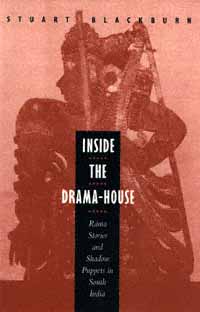 | Title: Inside the drama-house: Rama stories and shadow puppets in South India Author: Blackburn, Stuart H Published: University of California Press, 1996 Subjects: Anthropology | Asian Studies | South Asia | Cinema and Performance Arts | Hinduism Publisher's Description: Stuart Blackburn takes the reader inside a little-known form of shadow puppetry in this captivating work about performing the Tamil version of the Ramayana epic. Blackburn describes the skill and physical stamina of the puppeteers in Kerala state in South India as they perform all night for as many as ten weeks during the festival season. The fact that these performances often take place without an audience forms the starting point for Blackburn's discussion - one which explores not only this important epic tale and its performance, but also the broader theoretical issues of text, interpretation, and audience.Blackburn demonstrates how the performers adapt the narrative and add their own commentary to re-create the story from a folk perspective. At a time when the Rama story is used to mobilize political movements in India, the puppeteers' elaborate recitation and commentary presents this controversial tale from another ethical perspective, one that advocates moral reciprocity and balance.While the study of folk narrative has until now focused on tales, tellers, and tellings, this work explores the importance of audience - absent or otherwise. Blackburn's elegant translations of the most dramatic and pivotal sequences of the story enhance our appreciation of this unique example of performance art. [brief] Similar Items |
| 5. | 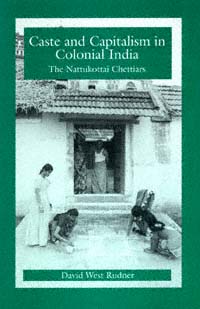 | Title: Caste and capitalism in colonial India: the Nattukottai Chettiars Author: Rudner, David West Published: University of California Press, 1994 Subjects: Anthropology | Cultural Anthropology | South Asia | Asian History Publisher's Description: David Rudner's richly detailed ethnographic and historical analysis of a South Indian merchant-banking caste provides the first comprehensive analysis of the interdependence among Indian business practice, social organization, and religion. Exploring noncapitalist economic formations and the impact of colonial rule on indigenous commercial systems, Rudner argues that caste and commerce are inextricably linked through formal and informal institutions. The practices crucial to the formation and distribution of capital are also a part of this linkage. Rudner challenges the widely held assumptions that all castes are organized either by marriage alliance or status hierarchy and that caste structures are incompatible with the "rational" conduct of business. [brief] Similar Items |
| 6. | 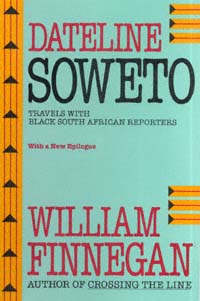 | Title: Dateline Soweto: travels with black South African reporters Author: Finnegan, William Published: University of California Press, 1995 Subjects: Media Studies | African Studies | Social Problems | Politics | African History Publisher's Description: Dateline Soweto documents the working lives of black South African reporters caught between the mistrust of militant blacks, police harrassment, and white editors who - fearing government disapproval - may not print the stories these reporters risk their lives to get. William Finnegan revisited seve . . . [more] Similar Items |
| 7. | 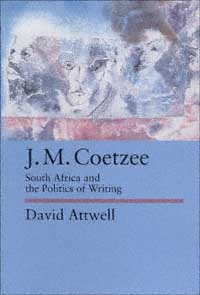 | Title: J.M. Coetzee: South Africa and the politics of writing Author: Attwell, David Published: University of California Press, 1993 Subjects: Literature | African Studies | Literary Theory and Criticism Publisher's Description: David Attwell defends the literary and political integrity of South African novelist J.M. Coetzee by arguing that Coetzee has absorbed the textual turn of postmodern culture while still addressing the ethical tensions of the South African crisis. As a form of "situational metafiction," Coetzee's writing reconstructs and critiques some of the key discourses in the history of colonialism and apartheid from the eighteenth century to the present. While self-conscious about fiction-making, it takes seriously the condition of the society in which it is produced.Attwell begins by describing the intellectual and political contexts surrounding Coetzee's fiction and then provides a developmental analysis of his six novels, drawing on Coetzee's other writings in stylistics, literary criticism, translation, political journalism and popular culture. Elegantly written, Attwell's analysis deals with both Coetzee's subversion of the dominant culture around him and his ability to see the complexities of giving voice to the anguish of South Africa. [brief] Similar Items |
| 8. | 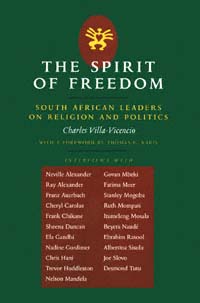 | Title: The spirit of freedom: South African leaders on religion and politics Author: Villa-Vicencio, Charles Published: University of California Press, 1996 Subjects: Religion | Politics | African Studies Publisher's Description: This collection of interviews explores the role of religion in the lives of eminent South Africans who led the struggle against apartheid. Nelson Mandela, Chris Hani, Desmond Tutu, Nadine Gordimer, and seventeen other political, religious, and cultural leaders share the beliefs and values that informed the moral positions they adopted, often at great cost. From all ethnic, religious, and political backgrounds, these men and women have shaped one of the greatest political transformations of the century.What emerges from the interviews are reflections on all aspects of life in an embattled country. There are stories of the homelands and townships, and tales of imprisonment and exile. Dedicated communists relate their intense youthful devotion to Christianity; Muslim activists discuss the complexity of their relationships with their communities. As the respondents grapple with difficult questions about faith, politics, and authority, they expose a more personal picture: of their daily lives, of their pasts, and of the enormous conflicts that arise in a society that continually strains the moral fiber of its citizens. Taken together, these interviews reveal the many-faceted vision that has fueled South Africa's struggle for democracy. [brief] Similar Items |
| 9. | 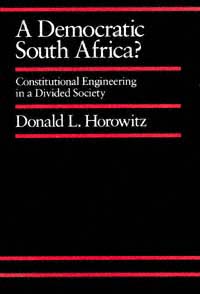 | Title: A democratic South Africa?: constitutional engineering in a divided society Author: Horowitz, Donald L Published: University of California Press, 1991 Subjects: Politics | African Studies | Sociology | Law Publisher's Description: Can a society as deeply divided as South Africa become democratic? In a most timely work, Donald L. Horowitz, author of the acclaimed Ethnic Groups in Conflict , points to the conditions that make democracy an improbable outcome in South Africa. At the same time, he identifies ways to overcome these obstacles, and he describes institutions that offer constitution makers the best chance for a democratic future.South Africa is generally considered an isolated case, a country unlike any other. Drawing on his extensive experience of racially and ethnically divided societies, however, Horowitz brings South Africa back into African and comparative politics. Experience gained in Nigeria, Botswana, Zimbabwe, and other divided societies around the world is relevant because, as South Africa leaves apartheid behind, it will still confront problems of pluralism: racial, ethnic, and ideological. Countries like South Africa, Horowitz argues, must develop institutions capable of coping with such divisions.Reviewing an array of constitutional proposals for South Africa - group rights, consociation, partition, binationalism, and an enhanced role for the judiciary - Horowitz shows that most are inappropriate for the country's problems, or else run afoul of some major ideological taboo. Institutions that are both apt and acceptable do exist, however. These are premised on the need to create incentives for accommodation across group lines. In the final chapter, Horowitz makes a major contribution to the theory of democratization as he considers how commitments to democracy might be extracted even from political groups with undemocratic objectives.Ranging skillfully across studies of social distance and stereotypes, electoral and party systems, constitutions and judiciaries, conflict and accommodation, and negotiation and democratization, Horowitz displays a broad comparative vision. His innovative study will change the way theorists and practitioners approach the task of making democracy work in difficult conditions. [brief] Similar Items |
| 10. | 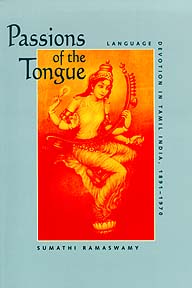 | Title: Passions of the tongue: language devotion in Tamil India, 1891-1970 Author: Ramaswamy, Sumathi Published: University of California Press, 1997 Subjects: Asian Studies | History | South Asia | Language and Linguistics | Asian History | Asian Literature Publisher's Description: Why would love for their language lead several men in southern India to burn themselves alive in its name? Passions of the Tongue analyzes the discourses of love, labor, and life that transformed Tamil into an object of such passionate attachment, producing in the process one of modern India's most intense movements for linguistic revival and separatism. Sumathi Ramaswamy suggests that these discourses cannot be contained within a singular metanarrative of linguistic nationalism and instead proposes a new analytic, "language devotion." She uses this concept to track the many ways in which Tamil was imagined by its speakers and connects these multiple imaginings to their experience of colonial and post-colonial modernity. Focusing in particular on the transformation of the language into a goddess, mother, and maiden, Ramaswamy explores the pious, filial, and erotic aspects of Tamil devotion. She considers why, as its speakers sought political and social empowerment, metaphors of motherhood eventually came to dominate representations of the language. [brief] Similar Items |
| 11. | 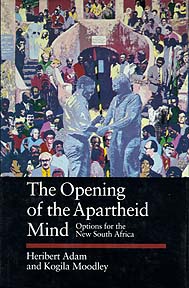 | Title: The opening of the Apartheid mind: options for the new South Africa Author: Adam, Heribert Published: University of California Press, 1993 Subjects: African Studies | Politics | African History Publisher's Description: Refusing to be governed by what is fashionable or inoffensive, Heribert Adam and Kogila Moodley frankly address the passions and rationalities that drive politics in post-apartheid South Africa. They argue that the country's quest for democracy is widely misunderstood and that public opinion abroad relies on stereotypes of violent tribalism and false colonial analogies.Adam and Moodley criticize the personality cult surrounding Nelson Mandela and the accolades accorded F. W. de Klerk. They reject the black-versus-white conflict and substitute sober analysis and strategic pragmatism for the moral outrage that typifies so much writing about South Africa. Believing that the best expression of solidarity emanates from sympathetic but candid criticism, they pose challenging questions for the African National Congress and Nelson Mandela. They give in-depth coverage to political violence, the ANC-South African Communist Party alliance, Inkatha, and other controversial topics as well.The authors do not propose a solution that will guarantee a genuinely democratic South Africa. What they offer is an understanding of the country's social conditions and political constraints, and they sketch options for both a new South Africa and a new post-Cold War foreign policy for the whole of southern Africa. The importance of this book is as immediate as today's headlines. [brief] Similar Items |
| 12. | 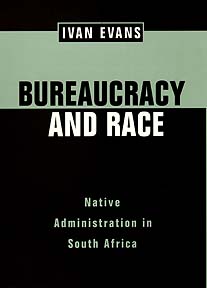 | Title: Bureaucracy and race: native administration in South Africa Author: Evans, Ivan Thomas 1957- Published: University of California Press, 1997 Subjects: African Studies | African History | Sociology | Postcolonial Studies | Cultural Anthropology Publisher's Description: Bureaucracy and Race overturns the common assumption that apartheid in South Africa was enforced only through terror and coercion. Without understating the role of violent intervention, Ivan Evans shows that apartheid was sustained by a great and ever-swelling bureaucracy. The Department of Native Affairs (DNA), which had dwindled during the last years of the segregation regime, unexpectedly revived and became the arrogant, authoritarian fortress of apartheid after 1948. The DNA was a major player in the prolonged exclusion of Africans from citizenship and the establishment of a racially repressive labor market. Exploring the connections between racial domination and bureaucratic growth in South Africa, Evans points out that the DNA's transformation of oppression into "civil administration" institutionalized and, for whites, legitimized a vast, coercive bureaucratic culture, which ensnared millions of Africans in its workings and corrupted the entire state. Evans focuses on certain features of apartheid - the pass system, the "racialization of space" in urban areas, and the cooptation of African chiefs in the Bantustans - in order to make it clear that the state's relentless administration, not its overtly repressive institutions, was the most distinctive feature of South Africa in the 1950s. All observers of South Africa past and present and of totalitarian states in general will follow with interest the story of how the Department of Native Affairs was crucial in transforming "the idea of apartheid" into a persuasive - and all too durable - practice. [brief] Similar Items |
| 13. | 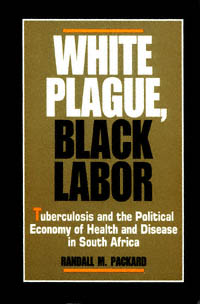 | Title: White plague, black labor: tuberculosis and the political economy of health and disease in South Africa Author: Packard, Randall M 1945- Published: University of California Press, 1989 Subjects: Anthropology | Medicine | Medical Anthropology | African Studies | Politics Publisher's Description: Why does tuberculosis, a disease which is both curable and preventable, continue to produce over 50,000 new cases a year in South Africa, primarily among blacks? In answering this question Randall Packard traces the history of one of the most devastating diseases in twentieth-century Africa, against the background of the changing political and economic forces that have shaped South African society from the end of the nineteenth century to the present. These forces have generated a growing backlog of disease among black workers and their families and at the same time have prevented the development of effective public health measures for controlling it. Packard's rich and nuanced analysis is a significant contribution to the growing body of literature on South Africa's social history as well as to the history of medicine and the political economy of health. [brief] Similar Items |
| 14. | 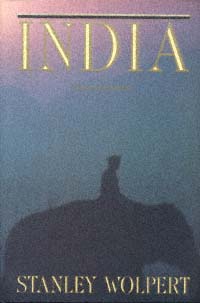 | Title: India Author: Wolpert, Stanley A 1927- Published: University of California Press, 1990 Subjects: History | South Asia | Asian History Publisher's Description: The history of India is the engrossing story of an ancient civilization, reborn as a modern nation. More a continent than a single nation, India is home to over one-fifth of humanity, yet it remains a mystery to most non-Indians, barely appreciated and poorly understood. Stanley Wolpert's India provides a much-needed, concise overview of Indian history and culture. His new preface brings the book up to date, discussing national elections, the economic effects of the new globalization, and the consequences of joining the nuclear arms race. [brief] Similar Items |
| 15. | 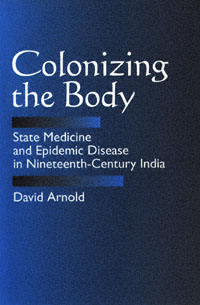 | Title: Colonizing the body: state medicine and epidemic disease in nineteenth-century India Author: Arnold, David 1946- Published: University of California Press, 1993 Subjects: Asian Studies | South Asia | Asian History | Medicine | History Publisher's Description: In this innovative analysis of medicine and disease in colonial India, David Arnold explores the vital role of the state in medical and public health activities, arguing that Western medicine became a critical battleground between the colonized and the colonizers.Focusing on three major epidemic diseases - smallpox, cholera, and plague - Arnold analyzes the impact of medical interventionism. He demonstrates that Western medicine as practiced in India was not simply transferred from West to East, but was also fashioned in response to local needs and Indian conditions.By emphasizing this colonial dimension of medicine, Arnold highlights the centrality of the body to political authority in British India and shows how medicine both influenced and articulated the intrinsic contradictions of colonial rule. [brief] Similar Items |
| 16. | 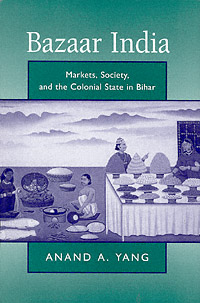 | Title: Bazaar India: markets, society, and the colonial state in Gangetic Bihar Author: Yang, Anand A Published: University of California Press, 1999 Subjects: Asian Studies | South Asia | Asian History | Economics and Business Publisher's Description: The role of markets in linking local communities to larger networks of commerce, culture, and political power is the central element in Anand A. Yang's provocative and original study. Yang uses bazaars in the northeast Indian state of Bihar during the colonial period as the site of his investigation. The bazaar provides a distinctive locale for posing fundamental questions regarding indigenous societies under colonialism and for highlighting less familiar aspects of colonial India.At one level, Yang reconstructs Bihar's marketing system, from its central place in the city of Patna down to the lowest rung of the periodic markets. But he also concentrates on the dynamics of exchanges and negotiations between different groups and on what can be learned through the "voices" of people in the bazaar: landholders, peasants, traders, and merchants. Along the way, Yang uncovers a wealth of details on the functioning of rural trade, markets, fairs, and pilgrimages in Bihar.A key contribution of Bazaar India is its many-stranded narrative history of some of South Asia's primary actors over the past two centuries. But Yang's approach is not that of a detached observer; rather, his own voice is engaged with the voices of the past and with present-day historians. By focusing on the world beyond the mud walls of the village, he widens the imaginative geography of South Asian history. Readers with an interest in markets, social history, culture, colonialism, British India, and historiographic methods will welcome his book. [brief] Similar Items |
| 17. | 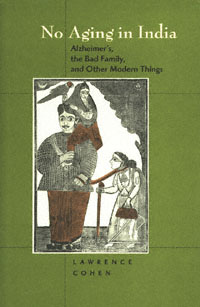 | Title: No aging in India: Alzheimer's, the bad family, and other modern things Author: Cohen, Lawrence 1961- Published: University of California Press, 1998 Subjects: Anthropology | Medical Anthropology | Aging | South Asia Publisher's Description: From the opening sequence, in which mid-nineteenth-century Indian fishermen hear the possibility of redemption in an old woman's madness, No Aging in India captures the reader with its interplay of story and analysis. Drawing on more than a decade of ethnographic work, Lawrence Cohen links a detailed investigation of mind and body in old age in four neighborhoods of the Indian city of Varanasi (Banaras) with events and processes around India and around the world. This compelling exploration of senility - encompassing not only the aging body but also larger cultural anxieties - combines insights from medical anthropology, psychoanalysis, and postcolonial studies. Bridging literary genres as well as geographic spaces, Cohen responds to what he sees as the impoverishment of both North American and Indian gerontologies - the one mired in ambivalence toward demented old bodies, the other insistent on a dubious morality tale of modern families breaking up and abandoning their elderly. He shifts our attention irresistibly toward how old age comes to matter in the constitution of societies and their narratives of identity and history. [brief] Similar Items |
| 18. | 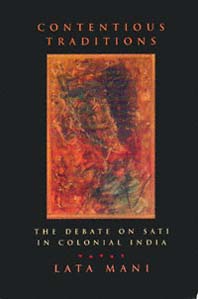 | Title: Contentious traditions: the debate on Sati in colonial India Author: Mani, Lata 1956- Published: University of California Press, 1998 Subjects: History | South Asia | Postcolonial Studies Publisher's Description: Contentious Traditions analyzes the debate on sati , or widow burning, in colonial India. Though the prohibition of widow burning in 1829 was heralded as a key step forward for women's emancipation in modern India, Lata Mani argues that the women who were burned were marginal to the debate and that the controversy was over definitions of Hindu tradition, the place of ritual in religious worship, the civilizing missions of colonialism and evangelism, and the proper role of the colonial state. Mani radically revises colonialist as well as nationalist historiography on the social reform of women's status in the colonial period and clarifies the complex and contradictory character of missionary writings on India.The history of widow burning is one of paradox. While the chief players in the debate argued over the religious basis of sati and the fine points of scriptural interpretation, the testimonials of women at the funeral pyres consistently addressed the material hardships and societal expectations attached to widowhood. And although historiography has traditionally emphasized the colonial horror of sati , a fascinated ambivalence toward the practice suffused official discussions. The debate normalized the violence of sati and supported the misconception that it was a voluntary act of wifely devotion.Mani brilliantly illustrates how situated feminism and discourse analysis compel a rewriting of history, thus destabilizing the ways we are accustomed to look at women and men, at "tradition," custom, and modernity. [brief] Similar Items |
| 19. | 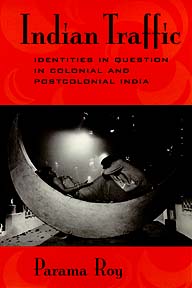 | Title: Indian traffic: identities in question in colonial and postcolonial India Author: Roy, Parama Published: University of California Press, 1998 Subjects: Postcolonial Studies | Literary Theory and Criticism | South Asia | Gender Studies Publisher's Description: The continual, unpredictable, and often violent "traffic" between identities in colonial and postcolonial India is the focus of Parama Roy's stimulating and original book. Mimicry has been commonly recognized as an important colonial model of bourgeois/elite subject formation, and Roy examines its place in the exchanges between South Asian and British, Hindu and Muslim, female and male, and subaltern and elite actors. Roy draws on a variety of sources - religious texts, novels, travelogues, colonial archival documents, and films - making her book genuinely interdisciplinary. She explores the ways in which questions of originality and impersonation function, not just for "western" or "westernized" subjects, but across a range of identities. For example, Roy considers the Englishman's fascination with "going native," an Irishwoman's assumption of Hindu feminine celibacy, Gandhi's impersonation of femininity, and a Muslim actress's emulation of a Hindu/Indian mother goddess. Familiar works by Richard Burton and Kipling are given fresh treatment, as are topics such as the "muscular Hinduism" of Swami Vivekananda. Indian Traffic demonstrates that questions of originality and impersonation are in the forefront of both the colonial and the nationalist discourses of South Asia and are central to the conceptual identity of South Asian postcolonial theory itself. [brief] Similar Items |
| 20. | 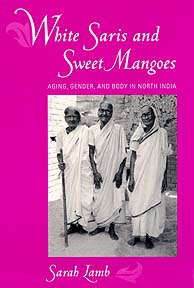 | Title: White saris and sweet mangoes: aging, gender, and body in North India Author: Lamb, Sarah 1960- Published: University of California Press, 2000 Subjects: Anthropology | South Asia | Aging | Cultural Anthropology | Women's Studies Publisher's Description: This rich ethnography explores beliefs and practices surrounding aging in a rural Bengali village. Sarah Lamb focuses on how villagers' visions of aging are tied to the making and unmaking of gendered selves and social relations over a lifetime. Lamb uses a focus on age as a means not only to open up new ways of thinking about South Asian social life, but also to contribute to contemporary theories of gender, the body, and culture, which have been hampered, the book argues, by a static focus on youth. Lamb's own experiences in the village are an integral part of her book and ably convey the cultural particularities of rural Bengali life and Bengali notions of modernity. In exploring ideals of family life and the intricate interrelationships between and within generations, she enables us to understand how people in the village construct, and deconstruct, their lives. At the same time her study extends beyond India to contemporary attitudes about aging in the United States. This accessible and engaging book is about deeply human issues and will appeal not only to specialists in South Asian culture, but to anyone interested in families, aging, gender, religion, and the body. [brief] Similar Items |